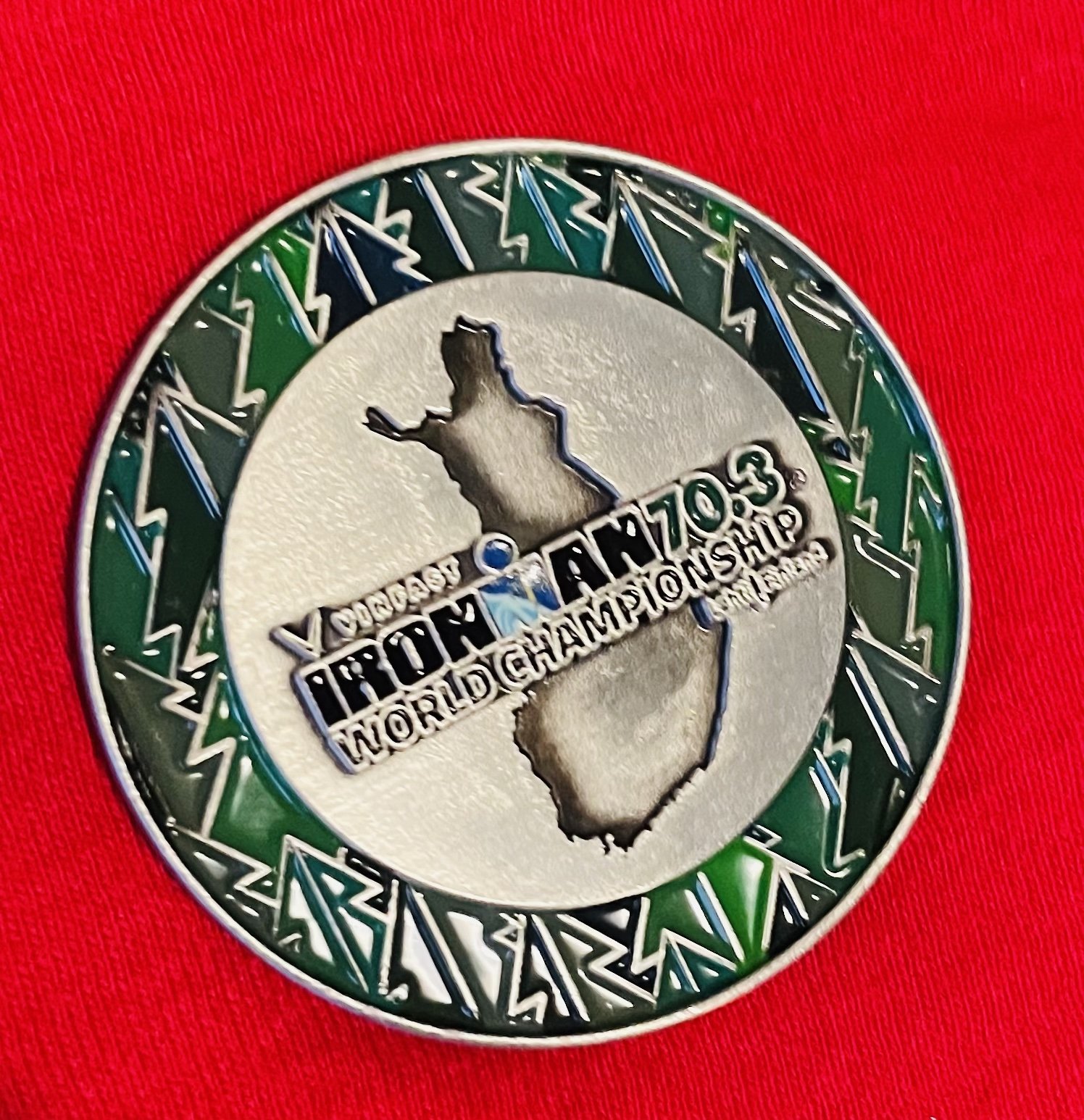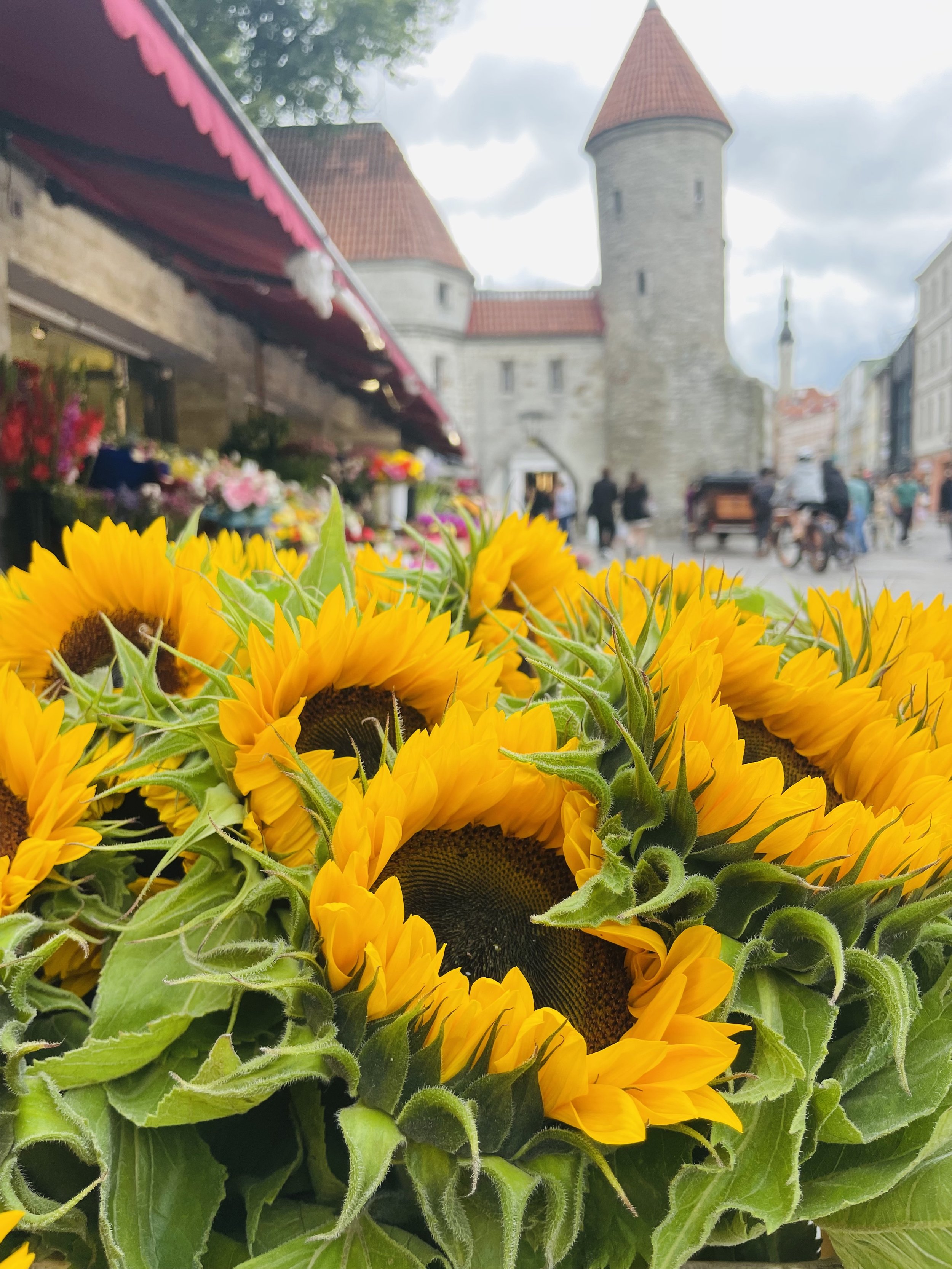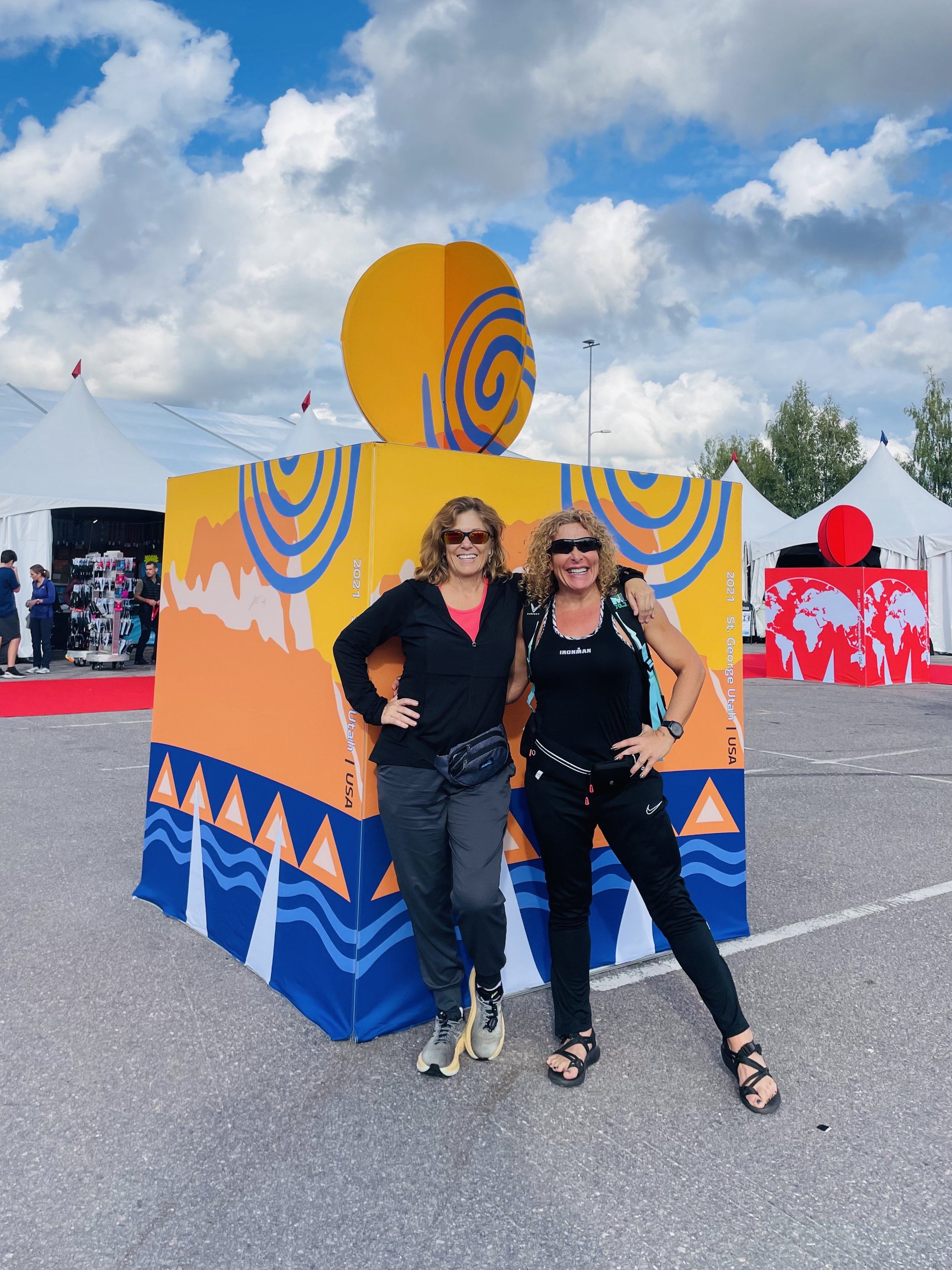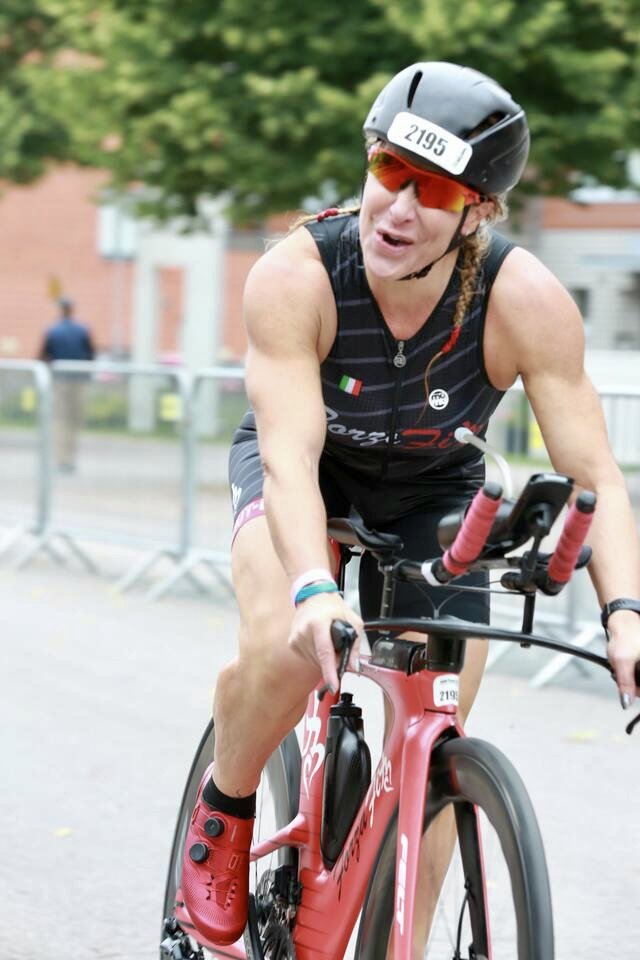View of the lake.
I’m fit, healthy and injury free again. Crossing Finland IRONMAN 70.3 World Championship 2023 finish line today was an incredible achievement, and it is opening a new chapter in my life! I lost count of how many triathlons, swim, bike and run races I did and won but this felt like racing for the first time again! My goal for this race was just to finish and feel good after not racing in over 1.5 years.
So I can proudly say: Another IRONMAN 70.3 World Championship in my books! I can’t express how happy and thankful I am to God and to all the experts who helped me achieve this goal, especially after overcoming a hip injury (almost 90% recovered) and a stubborn UTI infection. My mantras are still alive: “Anything is possible!" "ShutupLegs!" "Everything happens for a good reason!"
Over a year and a half ago, I was advised to give up on triathlons due to the severity of my injury. My Athletic Trainer, Larry Mayol, even told me, "You probably won't be able to compete in the IRONMAN 70.3 World Championship 2023 in Finland." Well, I have once again proven them wrong. This time, I am more aware than ever of the importance of proper recovery and maintaining a harmonious balance of both mind and body.
Leading to this race
Over the past year, I have consulted over 100 doctors, specialists, and therapists. While many doctors advised against running, there were numerous others who provided invaluable support throughout my journey. My medical diagnosis included a proximal hamstring almost full avulsion, hip impingement, quadratus femoris tear, labral tear, tendinopathy, SI joint dysfunction, and L5 bilateral pair fracture……
I explored various treatments, such as PRP therapy, extended periods of rest (including 8 months without running), dry needling, acupuncture, physical therapy, massages, wave therapy, NCV tests, chiropractic care, adjustments to my running technique, and bike fit modifications, among others. This experience has been an immense learning opportunity for me, and I continue to gain insights. I firmly believe that everything unfolds for a purpose. This journey has underscored the significance of recovery, even when we may feel invincible. It has taught me that, even if you're unwilling to relinquish your dreams, there's room for adaptation, patience, and a dedicated focus on healing both the body and the mind.
There were numerous instances when I felt disheartened and found myself immersed in a whirlwind of emotions, shedding tears of pain and frustration. Now, let's delve into the recap of the race.
Pre Race
Traveling to Finland was a bit concerning due to the weather forecast. I am a sunny person. I do not like cold and rainy days. However, we need to learn how to channel anxiety to excitement. Right?
My friend April and I arrived in Finland on Wednesday August 23. The women’s race was on Saturday August 26. April said: " I am starting to think that you are really a "sun maker"! In fact we never had the expected rain during our stay, not even on race day.
…….
…
I practiced the cold swim on Thursday and Friday morning. I wanted to acclimate to the cold water since in Florida we had water temperature above 95 degrees. I panicked the first time. It was cold, foggy and dark. The second time was already a bit better and the day after was even better. This is why I always suggest to all my athletes to get on the race site at least a couple of days before to acclimate and to figure out logistics. This race had 2 transitions, so figuring out race day flow was a bit challenging.
Race day
It was cold, but not too bad. Race start was delayed due to heavy fog. Since I was in the last wave, I didn't begin until 9:36 am. I did what I could to stay topped up on calories and fluids.
Shortly, after watching the Pros swim start and finish, it was time to line up for the start. I spent a considerable amount of time before the start. More than 3,000 athletes in wetsuits were standing around on the harbor walkway, not doing much of anything besides trying not to get too cold or warm, depending on whether or not the athlete had dipped themselves into the chilly lake during warm-up.….
After what felt like two and a half eternities, the participants finally started to shuffle towards the dock from which the age-groupers were now jumping into the water. I FINALLY got a view of the part of the lake where hundreds of competitors were now furiously jumping to make any headway they could. Ultimately, it was probably for the best that I only had a moment to consider the predicament I found myself in of having to jump from a dock.
The Swim: Cold for a Floridian and murky for a spoiled Neapolitan.
As I jumped in the dark water, things just fell into place. The anxiety, uncertainty, and downright panic I had feared would strike me at that moment simply did not show up to the party. I was also happy to note that the water was certainly not unfathomably cold. (In fact, the water was about 18 C.) All in all, I was happily splashing along before I knew it.
The swim course was point to point with 3 turns, so I mentally broke it down into 4 parts. Of these, the first stretch felt the longest, as usual because I need at least 10 min to start feeling the "race pace", and I also got off the course a bit.….
…
Looking at my Garmin file, it seems I managed to keep a 2:00 min per 100 yds pace during the swim, which is good as I went smooth and easy. The less than ideal part of the swim is according to the Garmin file, I managed to pull myself through about 200 yds of extra water (for a total of 2,247 yd), which certainly didn’t help my swim time. Most of the extra distance probably accumulated on the first stretch toward the first turn, as I got off the course for a bit.
The final leg of the swim seemed to stretch on forever. Nevertheless, I should probably be grateful that it felt more like the "I'm bored and are we there yet?" kind of eternity, rather than the "I'm suffocating and need oxygen" type.
Ultimately, I got out of the water 42 minutes and 39 seconds into the race. Not too bad considering that I am not a strong swimmer in dark fresh water.
Transition (T1)
My T1 experience is easy to summarize: it was long.
I spent 6 minutes and 35 seconds in the first transition. Yes, you read that right. The run from the dock to the transition area seemed unusually long for us age groupers. Furthermore, it felt like an eternity as I struggled to remove my wetsuit. I might have temporarily forgotten the process after a 1.5-year hiatus from racing. However, I have to admit it, I took it easy. I wanted to just enjoy my return to Ironman racing.
The Bike: Beautiful, Hilly, Scenic and Safe
As I started pedaling my bike up to speed in the streets leading out of the Lahti central area, I quickly realized that it was impossible to both maintain a decent speed and stay the prescribed distance behind the next rider in front of you.
The only option I saw was to permanently establish myself in the passing lane.…
…
To keep myself from burning out, I selected a conservative normalized power (NP) goal of 70-75 % FTP and stuck with it – with the hope of ramping up towards the end if I was feeling good. Thus, I chose the more conservative route to make sure I had the legs to run the half marathon looming after the bike. Leading to this race, I did not run as much as I used to.
On the 10 miles west from Lahti towards the first aid station in Hollola, I remained solidly grounded in the passing lane. I suppose this was a natural consequence of my relatively poor swim, T1 performances and being in the last wave. At that point, my legs felt good and the pace was easy, but of course it was not time to celebrate yet, given the remaining 46 miles. Meanwhile, my mood was gradually beginning to sour from the overcast weather on the stretch to Hollola (I love the sun and hate wet roads and downhills).
As I was rolling along, I looked at the speed fields on my Garmin. The avg. power was roughly at 70% FTP and speed at 20 mph. The first part of the course was the easiest.
…..
…
Leaving Hollola behind, the sun came out to cheer on the race. The course still featured ups and downs in the form of rolling hills (the typical terrain for this part of Finland), but overall the course profile was clearly smoother considering that for roughly the same power my next two lap splits improved. I’m not sure if and to what extent the wind also contributed to this. The newly-found speed carried me all the way to the half-way point of the course, which was also the southernmost point of the loop. From there, the course follows a larger country road back towards Lahti. Given that there was not as much forest there to shield the road, I was exposed to reasonably strong headwinds.
A few kilometers before reaching the half-way aid station, the dreaded urge to pee had started creeping up on me. Given how early in the bike that happened, I was absolutely certain I wasn’t going to be able to finish the race without a nature break. I actually took 2. I was hydrated! Continuing on the road back towards Lahti, the headwind was slowing me down, but it didn’t feel as dreadful as headwinds typically do…..
…
On the last long hill, I must have passed at least 50 riders. I increased my effort slightly above my race power on the climb, but I certainly kept it within my goal and didn’t burn any matches.
The distance must have started to take its toll at this point, because many of the other riders seemed to struggle to keep their wheels turning.
After the climb, the course finished with a long, undulating descent back to Lahti. I thought it best to take it easy on the descents, especially those where I couldn’t see all the way to the bottom. I knew I couldn’t make up too much time here even at the best of times and I wanted to enjoy the fact that I could race again.
Rolling down towards transition, we had a very dangerous, technical downhill with no passing zone. Again, I took it easy. I was glad to finally ditch the bike and move on to the next leg of the race.
After 2 hours, 56 minutes, and 48 seconds, I was back in transition. I was feeling excellent. I had clearly not given everything I had out on the course, owing to my conservative race-day pacing strategy. Perhaps I could at least claim a defensive victory of sorts.
Transition (T2):
The second time around, the transition was not as much of a total disaster. The flow was long, but well organized (with the hanging bags and all that jazz).
I spent a total of 5 minutes and 52 seconds transitioning from the bike to the run. Yes, I took it easy considering the long distance.
The Run: Hilly, Chilly and Cheered
Running felt good. I felt like I was back in my element. Pacing-wise, my strategy of choice was to run the first 10 min by feel and see where my pace naturally settled. I’m usually decent at selecting an appropriate pace by feel, so I was confident enough to use this strategy in a race setting.
I knew I could not run my past best paces (8-8:30 mpm), so if feeling good I would aim for the 9:30 pace range, considering the hilly course. However, I was discouraged at the beginning of the course, when we were hit with a long challenging hill for over a mile.
It was sunny, but not bad for a Floridian considering the temperature was about 68. I took it easy and walked at every water station making sure I stayed hydrated. I also walked 10-15 sec on the steeper hills (there were quite a few).
…
I was happy to discover that after that long hill we were rewarded with some downhills where my pace went up to 7 mpm.
Finally, I was passing others on the run and not just being overtaken. The course continued with rolling hills and some flat stretches close to the scenic lake we swam in earlier. It was also a two-lap affair, so we had to rerun the hills again. We had to run over the IRONMAN man made bridge, a challenging, short steep hill 3 times, close to T2 (stadium). I speed walked this all 3 times.
The crowd of spectators gave me a huge energy boost from start to finish. After the first lap I knew I could manage to keep those paces (avg. 9:26). They varied based on the inclination on the roads. I am happy I was healthy and able to run without any pain.
I finished the run in 2 hours, 3 minutes, and 24 seconds. Certainly it was not the best run I had compared to my past 70.3s, but I was injury free! YAY! And the best thing is that I ran by feel. It was definitely an effort, but still a controlled one, with no dark moments to speak of.
After the Race
In total, I spent 5 hours, 55 minutes, and 17 seconds on the course.
This was my 5th IRONMAN 70.3 World Championship.
Crossing the finish line, I had tears of joy.
I am healthy again and I can still race!
Nutrition Strategy
Last, but not least, it’s finally time for a word or two on my nutrition strategy. Note: when referring to nutrition, I’m also referring to hydration.
● Before the swim, I had plenty of gatorade, water and half a banana.
● On the bike, 3 x 32 oz of water with Go Far Infinit
● During the run, 2 Martin gels, water and ice at every station.
Phew, that race report was almost as long as the race itself. I’m glad I got it out of the way just in time for my vacation.
Conclusion and Tips
Life has taught me, through this past year and many other thematic situations, that the darkest times can be a catalyst for our most extraordinary transformation. If we dare to hope, have faith, and get to work putting the pieces of your life together, our failure and scars can be the raw materials for character building and our most significant source of inspiration. Keep going, persevere, have faith, and overcome.... FORZA! Quitting isn’t an option.
1- Listen to your body. Our bodies always give us early working signs. While before I was doing the whole workout prescribed for the day, now I take breaks, naps, recovery routines and if I’m tired I skip it. A tired body would not perform well anyway... and then you would tear the muscles before they recovered. Is it worth it?
2- Eat well prior, during and after workouts. Forget about the diets. Diets don’t work. Just be healthy and love your body as it’s the only temple you truly own. Eat to perform. Emphasize the importance of nutrition to prevent or cure diseases. Food is our medicine.
3- Sleep well. While sleeping, the body is working to support healthy brain functions and maintain physical health. The body repairs cells, restores energy, and releases molecules like hormones and proteins. I am monitoring my sleep with my new Sleep number, an amazing bed. I shoot for 7-8 hours per night with enough deep and REM sleep.
4- Stretch to keep muscles flexible, strong, and healthy. Then guess what? You’ll move much better in everything you do in your daily life. I am stretching every day and still teaching ForzaFit Core, Hips, Flexibility, Yoga, Pilates Class (all in one to live and perform better). With this class, we feel much better in everything we do daily.
5- Focus on quality and not quantity. Even if in some distance races quantity becomes quality, we still need to monitor and analyze data to get the perfect intensity and duration ratios.
I want to thank:
1-My best friend and best sherpa ever April Critelli. She traveled all the way from the USA to Finland to cheer me on, offer unwavering support, and provide valuable guidance, especially during my challenging moments. Thanks from my heart!
2- My husband who's always supporting my training habits and crazy schedule.
3- My new Coach Tim Crowley. I finally found a coach who really focuses on recovery just as much as building. We cannot build effectively if we do not recover properly.



























